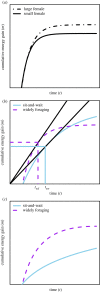The correlated evolution of foraging mode and reproductive effort in lizards
- PMID: 35673871
- PMCID: PMC9174732
- DOI: 10.1098/rspb.2022.0180
The correlated evolution of foraging mode and reproductive effort in lizards
Abstract
Life-history theory suggests that the optimal reproductive effort of an organism is affected by factors such as energy acquisition and predation risk. The observation that some organisms actively search for their prey and others ambush them creates the expectation of different energy needs and predation risk associated with each foraging behaviour, the so-called 'foraging-mode paradigm'. Although this paradigm has been around for decades, the empirical evidence consists of conflicting results derived from competing models based on different mechanisms. For instance, models within the foraging-mode paradigm suggest that widely foraging females have evolved low reproductive effort, because a heavy reproductive load decreases their ability to escape from predators. By contrast, a long-standing prediction of evolutionary theory indicates that organisms subject to high extrinsic mortality, should invest more in reproduction. Here, we present the first partial evidence that widely foraging species have evolved greater reproductive effort than have sit-and-wait species, which we attribute to a larger body size and greater mortality among mobile foragers. According to our findings, we propose a theoretical model that could explain the observed pattern in lizards, suggesting ways for evolutionary ecologists to test mechanistic hypotheses at the intraspecific level.
Keywords: clutch size; fecundity; maternal size; offspring size; phenotypic plasticity; predation.
Conflict of interest statement
We declare we have no competing interests.
Figures




Similar articles
-
Foraging mode, relative prey size and diet breadth: A phylogenetically explicit analysis of snake feeding ecology.J Anim Ecol. 2019 May;88(5):757-767. doi: 10.1111/1365-2656.12972. Epub 2019 Mar 22. J Anim Ecol. 2019. PMID: 30828806
-
Chemical discrimination by tongue-flicking in lizards: A review with hypotheses on its origin and its ecological and phylogenetic relationships.J Chem Ecol. 1994 Feb;20(2):439-87. doi: 10.1007/BF02064449. J Chem Ecol. 1994. PMID: 24242066
-
Reproductive tradeoff limits the predatory efficiency of female Arizona Bark Scorpions (Centruroides sculpturatus).BMC Evol Biol. 2013 Sep 14;13:197. doi: 10.1186/1471-2148-13-197. BMC Evol Biol. 2013. PMID: 24034444 Free PMC article.
-
Orchestration of avian reproductive effort: an integration of the ultimate and proximate bases for flexibility in clutch size, incubation behaviour, and yolk androgen deposition.Biol Rev Camb Philos Soc. 2006 Nov;81(4):629-66. doi: 10.1017/S1464793106007147. Epub 2006 Oct 12. Biol Rev Camb Philos Soc. 2006. PMID: 17038202 Review.
-
Dangerous prey and daring predators: a review.Biol Rev Camb Philos Soc. 2013 Aug;88(3):550-63. doi: 10.1111/brv.12014. Epub 2013 Jan 21. Biol Rev Camb Philos Soc. 2013. PMID: 23331494 Review.
Cited by
-
Latitudinal patterns of tree β-diversity and relevant ecological processes vary across spatial extents in forests of southeastern China.Plant Divers. 2024 Nov 13;47(1):89-97. doi: 10.1016/j.pld.2024.11.003. eCollection 2025 Jan. Plant Divers. 2024. PMID: 40041553 Free PMC article.
-
Active predators do not necessarily specialize in sedentary prey: A simulation model.Ann N Y Acad Sci. 2025 Jul;1549(1):199-207. doi: 10.1111/nyas.15379. Epub 2025 May 21. Ann N Y Acad Sci. 2025. PMID: 40400223 Free PMC article.
References
-
- Pianka ER. 1966. Convexity, desert lizards, and spatial heterogeneity. Ecology 47, 1055-1059. (10.2307/1935656) - DOI
-
- Vitt LJ, Congdon JD. 1978. Body shape, reproductive effort, and relative clutch mass in lizards: resolution of a paradox. Am. Nat. 112, 595-608. (10.1086/283300) - DOI
-
- Vitt LJ, Price HJ. 1982. Ecological and evolutionary determinants of relative clutch mass in lizards. Herpetologica 38, 237-255.
-
- Webb JK, Brook BW, Shine R. 2003. Does foraging mode influence life history traits? A comparative study of growth, maturation and survival of two species of sympatric snakes from south-eastern Australia. Austral Ecol. 28, 601-610. (10.1046/j.1442-9993.2003.t01-1-01316.x) - DOI
MeSH terms
Associated data
LinkOut - more resources
Full Text Sources

